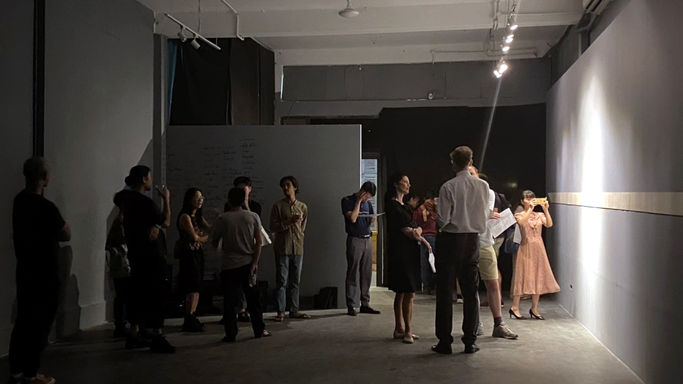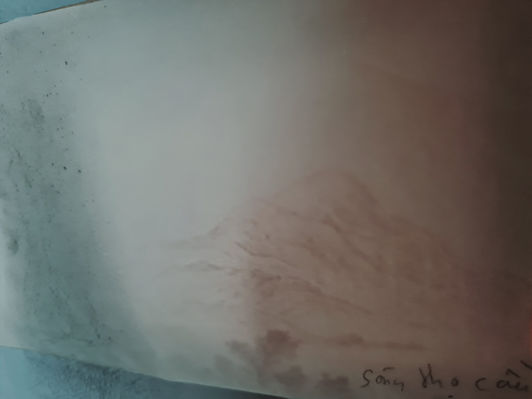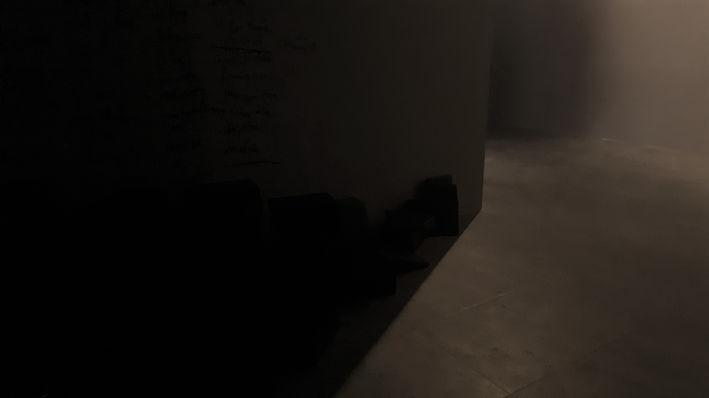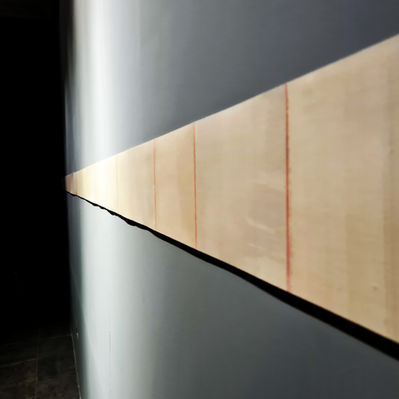
The Four Subjects
-
November 5, 2022
October 8, 2022
Nguyễn Huy An
For this comeback after three years (since his third solo show in Saigon), Huy An assembles an exclusive space for singular objects/relationships which would provoke an odd encounter of disparate subjects (they are essentially alien to each other and, at first sight, seemingly unfamiliar to the keen followers of Huy An’s art practices as well).
The new series of installation artworks features neither a reiteration of Huy An’s recurring motifs centered around his personal memories and the rural Northern Vietnam nor a replay of predominant themes such as local religious & spiritual dimensions and the divine & the profane which had often haunted Huy An’s practices with subtle shading of nostalgia for the past years. ‘The Four subjects’, nevertheless, is a display of his new and ongoing meditations on the potential possibilities of the visible / the action of seeing:
- A study of a very narrow blind area in the horse’s vision
- A reproduction of the comprehensive illustrated encyclopedia of Vietnamese Geography in the reign of Emperor Minh Mạng
- A co-presence of a lasting powerful light source and an ephemeral standard light with the minimum luminous intensity/ traces of its absence
- An extended thread of blanked-out images rhythmically punctuated with 51 bright colorful trails - effects of light leak in the first frames at the beginning of a film roll
A nuanced diagram of various scenarios, a bulleted list of prospects, with conciseness, clarity yet ambiguity, on the basis of diverse references. ‘Four Subjects’, therefore, resists the tendency to be interpreted as a coherent narrative that compels clear-cut messages or epic conclusions, but rather, provides clues of a puzzle lock. Scattered in a clear irreducible space, four sets of installations formulate somewhat of a tricky multi-point latching system; once this mechanism is unlocked with the right key, all pieces eventually fall into place. However, before the time comes, this arrangement, in the form of fragmented archives, is a dissonant structure. Apart from sharing some common characteristics in the artist’s reticence and restraint, along with the faint imprints of his personal codes (the light and shadow, the anonymous emptiness/ darkness and the futile attempt to preserve the remnants of vanishing cultures or to record the faded shades of the past), four installations of ‘The Four Subjects’, albeit connected in one theme called ‘seeing’, manifest themselves in a visual disharmony. This discordant presence sets off a tension of the haphazard and the random, of the absurdity and the evanescence, of the definitive and the infinite.
In that way, entailed in Four Subjects the implication of ‘Seeing or Not Seeing’/‘In sight or Out of sight’ is not a mutually exclusive claim or a two-choice question. Instead, a ‘No’ can be a ‘Yes’ and vice versa, everything is a metaphor. By confronting us with confounding variables in his experiment, Huy An opens up a free space that enables us to go beyond our limited perception which has always been dominated by our sense of sight and visual information.
*This is part of manzi’s art programme under the patronage of the Goethe Institut.
ARTWORKS
GALLERY
the four subjects
#1. Blind Spot
The very small blind area in the 350o range of horse’s vision
#2. Submerged in the layers of ‘cánh gián’
162 scenes within the penumbra of ‘cánh gián’- the layers of sơn ta coating
#3. Blindlingly dazzling point
A candle was illuminated by - the light power of 500 lumens (of a torch)
#4. A series of consecutivelines
...frame 1 blank frame 2 filled frame 3 blank frame 4 filled frame 5 blank frame 6 filled frame 7 blank frame 8 filled frame 9 blank frame 10 filled frame 11 blank frame 18 filled frame 19 blank frame 20 filled frame 21 blank frame 22 filled frame 28 blank frame 29 filled frame 30 blank frame 31 filled frame 32 blank frame 33 filled frame 34 blank frame 38 filled frame 39 blank frame 40 filled frame 41 blank frame 42 filled frame 43 blank frame 44 filled frame 45 blank frame 46 filled frame 47 blank frame 48 filled frame 49 blank frame 50 filled frame 51 blank frame 52 filled.
Between the ‘blank’ and ‘filled’ frames, there are lines in different vivid colors: red, yellow, orange, pink, magenta…
___________________________________________________________________
About the Four Subjects: A note for exhibition by Nguyễn Như Huy
1. The tragedy of ‘Oedipus the King’, from a specific perspective, can be viewed as a tale of paradoxical dialectics between ‘looking’ and ‘seeing’, ‘ sight’ and ‘insight’. Oedipus, regardless of his vision / ability to see, was totally blind to his reality, while Teiresias, the blind prophet, could simply see the truth. Finally, Oedipus paid for his crimes by self punishment: blinding himself. He destroyed his eyes - the tool of vision, because the truth had become known by then and he could live in the truth despite the physical blindness.
In some aspects, The Four Subjects by Nguyễn Huy An at Manzi, has approached such complex philosophical dialectical relations between ‘sight’ and ‘insight’ by means of visual arts. Huy An’s attempts in this visualization based on four questions (or four subjects - as the artist called them)
a/ The First Question is about an act of seeing yet insufficient/ incomplete. It is suggested in the ‘BLIND SPOT’ - the installation work simulated the vision range of the horse which expands 350 degrees.
b/ The Second Question asked in the installation titled ‘SUBMERGED IN THE LAYERS OF “CÁNH GIÁN” addresses the concealed visibility / an act of seeing yet hidden. This installation includes many small flat wooden boards (or “vóc”) of the same size like ancient Buddhist inscriptions, these are lacquer paintings on which are drawings of 162 scenes - the carving patterns can be found on The Nine Dynastic Urns of the Nguyen Dynasty. These 9 urns (‘Cửu Đỉnh’) were constructed by order of Emperor Minh Mạng (in 1837) with inspiration from the Xia’s Dynastic Urns of China. They were placed in front yard of The Mieu complex (the imperial temple worshiping the emperors of the Nguyen Dynasty). As a sacred treasure embodied the great power of the unified territory & the eternity of the Nguyen Dynasty, each urn was named after the posthumous title of an emperor. What’s special in Huy An’s adaptation is that: though had been painted, these lacquer baseboards were left without sanding or polishing but coated with a thick layer of ‘cánh gián’ (a soft brown color - like the cockroach wing). As a result, instead of resurfacing, all visual elements are hidden; this leads us to a realization: history itself has always been concealed by the manipulation of historical analysis & interpretation process.
c/ The Third Question is about a complete disappearance without absence, the situation of being vanished from sight while still being present. It is proposed in the installation called ‘BLINDINGLY DAZZLING POINT’ in which a flashlight power of 500 lumens directly focuses on a candle, instantaneously the candlelight ceases to be seen.
d/ The Fourth Question presents the relation between ‘Seeing’ and ‘Not Seeing’ in the last work ‘A SERIES OF CONSECUTIVE LINES’. This installation features a thread of light-leaked photos - a common error occurred with a film camera; images then could only be captured in one half of the frame while the other half went blank. And what did the artist do with these frames? He covered both the filled parts and the blank parts, only revealing the colored lines between them. Thus, it becomes apparent to us that Huy An has exposed the relation between ‘Seeing’ and ‘Not Seeing’ here: not mutually exclusive, they validate rather than negate each other. One can only be brought into being in the existence of another. In other words, ‘Seeing’ and ‘Not Seeing’ are both potentiality and actuality of each other.
2. FOUR SUBJECTS has, essentially, conceptualized the ‘Unseen’ / ‘Not Seeing’, or more precisely, the looking for a way to see the unseen / to get the insight into something out of sight. ‘Not Seeing’ does not equal having nothing to see, that is to say, a reality negative in the visual aspect. Rather, it is a perception of the limits of our visual acuity which ultimately affirms ‘what can be seen/known’ beyond our senses. To see the ‘not seeing’ therefore, is not a pure sophistry in the absurd paradoxical structure. Oppositely, this probably provides a kind of enlightenment, a perfect wisdom attained in the same way as The Heart Sutra of Buddhism has stated in the concept of śūnyatā (emptiness/nothingness): all things are empty of intrinsic existence and nature; transcending the seemingly conflicting relation of ‘form’ and ‘emptiness ’, śūnyatā is the essential core of all beings & universe.
OPENING NIGHT






























